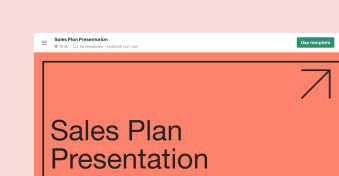Cold emailing is a difficult marketing strategy for two main reasons.
Your audience doesn’t know you and has no reason to trust you, and you don’t receive any feedback in real-time — either verbal or non-verbal — which makes it impossible to adapt your approach to their immediate reactions.
Instead, you have to wait for an eventual answer, which in many cases never comes.
Cold emails are emails sent without prior contact with the recipient, with the purpose of establishing a relationship and eventually making a sale.
Cold email strategies are one of the many tools in the toolbox of successful marketers, but arguably among the hardest to execute well.
At PandaDoc, we’re all about helping you level up your communications game.
We know that cold emailing can yield positive results when done correctly, and in this article, we’ll talk about the what, whys, and hows of cold emailing from top to bottom.
By the end, you’ll have a step-by-step blueprint you can use to build your own strategy — and transform those leads from feeling frosty to serious sizzle.
Are cold emails still effective?
The short answer is yes.
They can be effective, especially when combined with the right sales management software — and they definitely have their place in marketing, as well as a number of potential benefits you cannot get with other methods.
Cold emails are difficult, but this doesn’t make them ineffective — it just means that it’s complicated to get everything right, especially on the first try.
Or the first couple of tries, for that matter.
You usually need to experiment with a few different approaches to see what works best for your audience, and also be ready to spend time personalizing your emails.
Personalization is key.
It’s the most important strategy to use when sending emails to cold leads, and can really make or break your email campaign, so make sure you do your homework and tailor your emails to your recipients.
What is the goal of a cold email?
Cold emails have different goals and can be used in different scenarios.
For example, you can use cold emails to:
- Reach out to people or companies that might be interested in your products or services
- Start building a relationship with prospective leads
- Get people to sign up for a webinar, download a report, or come to an (online or offline) event
- Send a tailored proposal (which you can build with the help of one of our free templates for proposals or quotes)
- Negotiate a deal and make a sale, especially if you know the person is actively looking for a solution to a specific problem (for example, if they mentioned it in a LinkedIn post)
- Grow the email list or social media following of your organization
- Interview a subject-matter expert for your company’s blog, or get a quote from them to enhance one of your articles
- Negotiate backlinks to grow your online presence and boost your website’s rankings
As you can see, the goal of a cold email really depends on the context, lead, and overall objectives for the month or quarter.
Sales teams can successfully use cold emails to support other sales strategies and boost their performance, especially when they use the right software tools to manage leads and customer relationships.
Let’s say you invite a cold lead to sign up for a demo, and they do just that, and then ask you for a quote.
Using dedicated software, you can quickly draft the quote and send it over to them, together with the demo invite, in one streamlined process, and log everything into your CRM (e.g. Salesforce).
After that, the negotiation process becomes a breeze, and adjusting your rates or your offer is much easier than sending back and forth heavy PDF files.
Marketing teams can also make good use of cold emails to extend the reach of your company and the popularity of your solution or to build key marketing partnerships with experts or potential brand ambassadors.
What is the success rate of cold emails?
Generally, response rates for cold emails are low.
Although there’s no consensus or large-scale studies, many sources put them in the lower single digits: around 1% according to TaskDrive, or between 1% and 5% according to GMass.
However, when you take the time to personalize your cold emails, response rates can climb up significantly.
For example, even simple strategies like adding the name of the recipient in the subject line can increase open rates by 22%, according to PeerToPeer Marketing — and highly personalized emails can yield upwards of 30% response rates.
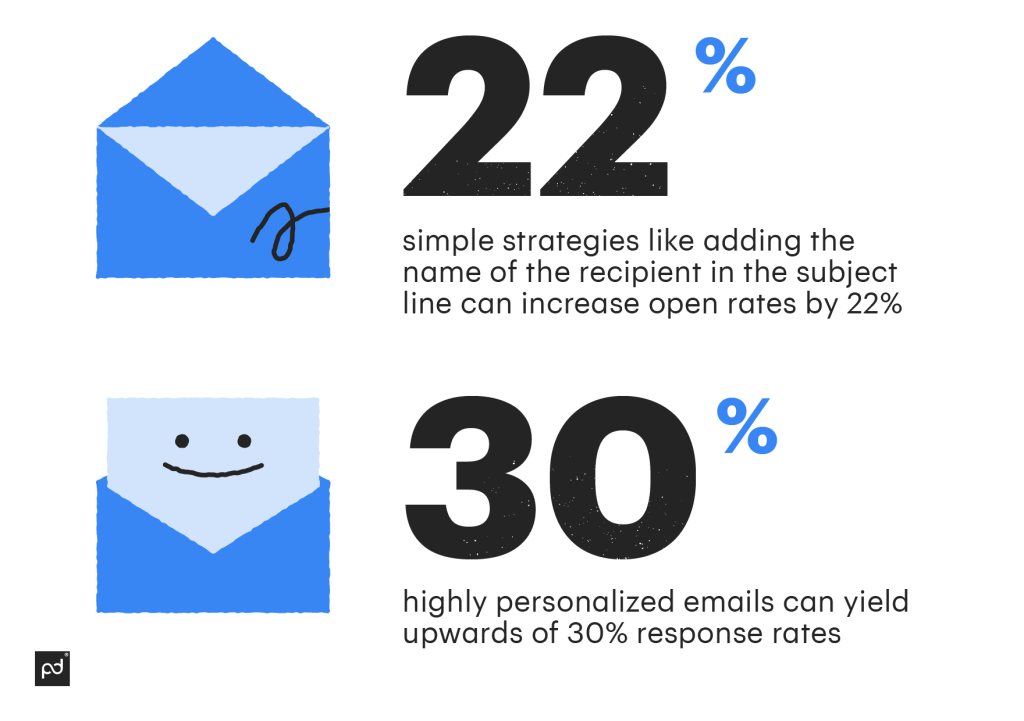
While we need to take these numbers with a grain of salt — reliable digital marketing data is difficult to come across — they do show an important trend.
If you design and execute your strategy correctly, you can significantly improve open and response rates and move from the territory of “This isn’t worth doing, we never get any replies” into the “We just landed another deal and now need to prepare the contract” zone.
Do B2B cold emails work?
Yes, B2B cold emails can be an effective lead-generation strategy, if done correctly.
To get the most out of your B2B cold email campaigns you need to:
- Set up your email accounts correctly
- Not buying mailing lists, which is considered a spam practice
- Personalize all emails you send out — generic ones won’t get you the results you’re after and you might even get flagged as spam
- Use short and snappy copy and clear CTAs
- Provide value and solve a specific pain point
In addition to that, using the right sales software tools — for contract management, CRM, payment, productivity, etc. — enables your sales reps to spend less time on data entry work, preparing PDFs, or manually scheduling meetings, and more time doing what they do best: sell.
With a contract management tool like PandaDoc, sales reps can greatly reduce the time they spend on preparing documents, and become much faster at getting contracts electronically signed — which helps them get more efficient and better equipped to serve new and returning customers.
Email templates for cold emails: yay or nay?
The answer is…it depends.
You can use cold email templates successfully but (and it’s really important) you need to always personalize them.
You cannot just copy and paste a template and expect to get any results. Instead, what you need to do is have a template that provides you with the structure of your email and then fill in the blanks with information that is highly relevant to your recipient.
Another caveat is that you cannot simply copy someone else’s template you found online — although if you search for “cold email templates” you’ll find plenty.
Your cold emails need to reflect your organization’s tone of voice, style, mission, and industry.
So, if you feel that templates are something you must have for your cold email strategy to be efficient and scalable — and we get it, writing every email from scratch takes so much time and effort — take the time to write your own templates.
Write a few for different use cases and always spice them up with a sentence or two (or three) you write each time, for each recipient.
How to create a winning cold email strategy: A step-by-step guide
Let’s proceed!
Below, you’ll find a detailed, step-by-step guide to creating a winning cold email strategy that not only helps you reach prospective clients’ inboxes but also makes them reach back to you.
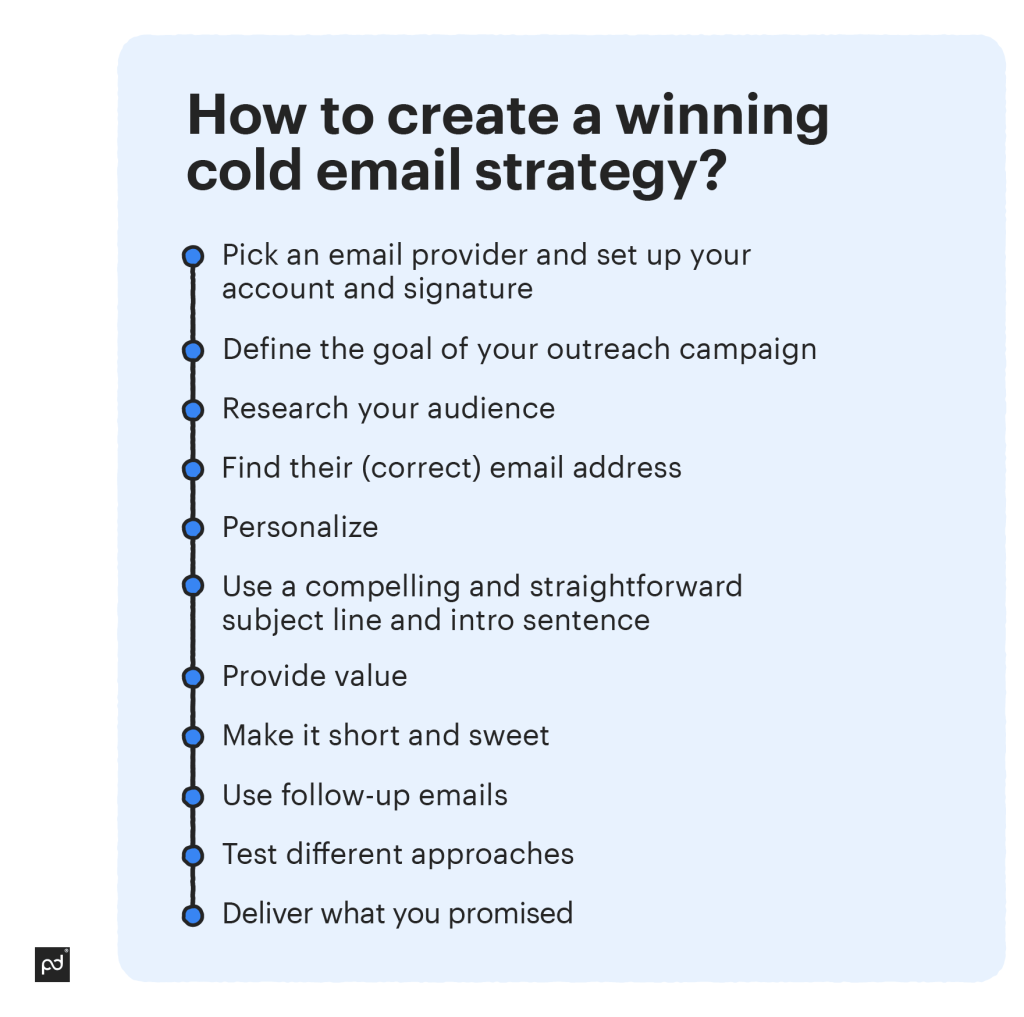
1. Pick an email provider and get things set up properly
The first step is to pick your email provider and set up your account, name, and signature. You have the option to use free (Hotmail, Gmail) or paid (Google Workspace) providers.
The best option for companies is to go with a paid provider.
This allows you to personalize the domain address, generally provides better delivery rates, and you also get higher daily limits (100 vs. 2000 for Google’s free vs. paid plan).
Your company is almost certainly already using a paid email provider, so you can simply check with your IT department on how you can create new email inboxes for the purposes of cold emailing.
Remember to add a professional signature; even better, include your photo to personalize the email even further (but make sure the signature is small in size, otherwise you risk poor delivery rates).
2. Define the goal of your outreach campaign
Next, you need to define what you want to achieve with this cold email campaign. Concentrate on a single goal that’s both realistic and measurable.
This will allow you to assess results easily after the campaign is over: You either achieved your goal or you didn’t.
So, what’s your goal? For example, it could be:
- To boost your sales for the quarter by 10%
- To sign up 5 more large clients in the next month
- To boost your organization’s LinkedIn following by 5%
- To negotiate 10 backlinks in the next 2 weeks
- To get at least 50 people to sign up for your next webinar
Having a specific goal will get you much farther than vague objectives such as “boost our sales” or “get more leads.”
3. Research your audience
Research is crucial for cold outreach because it enables you to personalize your messaging — if you skip this step, your open and response rates (and, ultimately, the success of your strategy) will suffer.
Research each person you plan to send a cold email to and create a personalized profile for them (for example, in your CRM system, as this will make it able to easily pull their information the next time you reach out to them, or if they reply.
You can still use templates, but profiles help you really get into the details of what each person might need, and they also allow you to segment your audience the right way.
4. Find their (correct) email address
If you send emails to non-existent email addresses, you’ll quickly lose credibility with your email provider and both your reputation and delivery rates will take a hit.
So, make sure you’re not guessing any email addresses; that you actually have the correct info.
You can use an email finder app (such as Hunter, LeadFuze, ViolaNorbert, or LeadGibbon, for example) to automate the process.
These apps usually scan large volumes of online data (company websites, profiles, blogs, etc.) to “hunt” an email address down and give it to you, ideally with the source where it was found.
You can also do that manually, but it requires more effort. For example, you can go to companies websites and look for employee data.
You can also “guess” the email address (many companies use this format: firstname.lastname@company.com or firstname@company.com) and then search for it in Google.
Alternatively, check the person’s LinkedIn profile: Not many people share their email addresses there, but some do.
Whatever you do, don’t buy email lists: This will harm your delivery rates and your domain and IP reputation.
5. Personalize, personalize, personalize
We all get tons of emails.
How many did you get today? 10? 20? 40? If you don’t make an effort to personalize your cold emails, you’ll never hear back from anyone.
So, how do you make your message feel personal?
Add the person’s name in the email and, even better, in the subject line.
Include specific information about the industry, the company, or the person’s work — all of which you have researched in advance.
For example, did they recently get promoted? Did their company have a particularly successful Series A round? Did they just open a new office location? Use this information to personalize your email.
And, most importantly, personalize it around the pain point of your recipient. Are they the head of a busy marketing department?
Maybe they’re really pressed for time — and for finding the right automation strategies.
Are they constrained by a tight business travel budget and looking for ways to optimize their employees’ spending on business trips?
Find out what your prospective lead really wants — or wants to escape from — to offer a tailored solution.
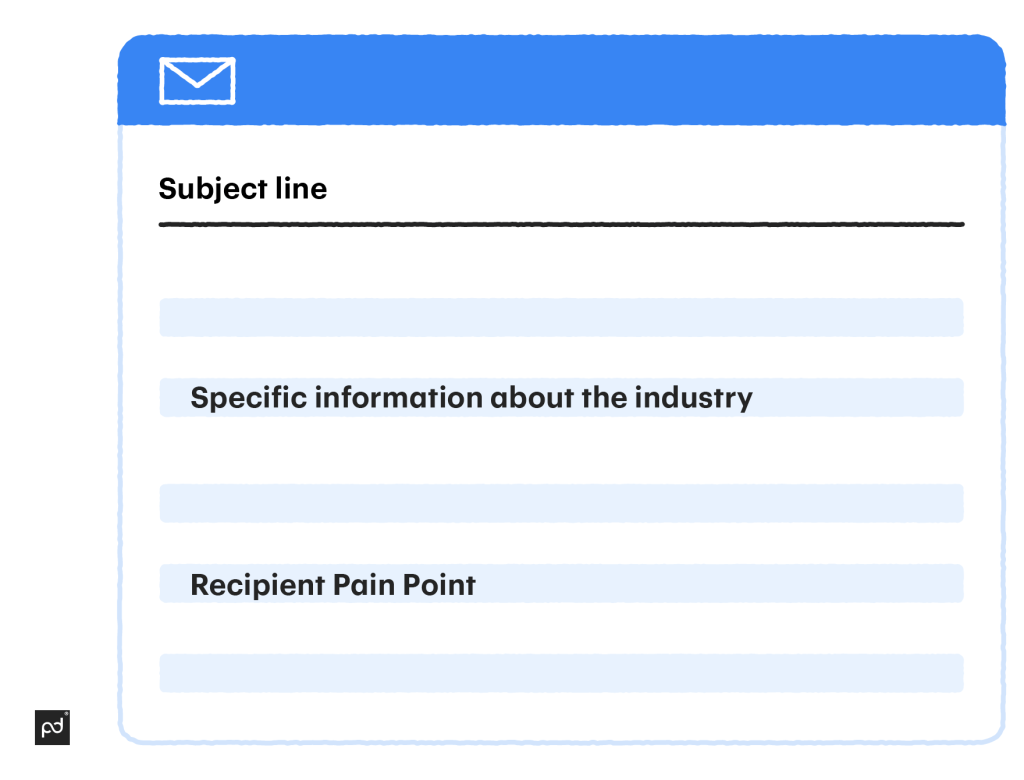
6. Use a compelling and straightforward subject line and intro sentence
The subject line and the intro sentence are the only two pieces of information that people will see to decide whether they should open your email or not.
Be direct and interesting with your short subject line: You don’t need to fit all the details in it, but you need to provoke enough interest and curiosity that the other person opens your email.
The intro sentence should also be straight to the point.
You can use it to say what’s in it for them or to introduce yourself, or mention a common connection you might have. Whichever you decide, get to the point, and fast.
Here are a few examples:
Example 1: A data security solution
Subject: Psst… Is your employees’ data secure?
Intro sentence: Data breaches can take 200+ days to identify and contain. Are you doing what’s needed to protect your employees’ data?
Example 2: A graphic design agency or a website builder
Subject: Andrea, here are 3 ways to make your new site even better
Intro sentence: Your site’s redesign looks neat! We have some tips on how to make it even better.
Example 3: A recruiting company
Subject: Struggling to find and hire senior developers?
Intro sentence: Senior developers are not easy to hire — here’s how to make the process easier.
7. Provide value
One of the best ways to get a response to a cold email is to provide value to the person receiving it and aim to relieve their pain or give them something they need or want. In other words, give them something valuable before you ask for something in return.
This might be a piece of advice or a quick preview of what you have to offer.
For example, if you’re selling a drag-and-drop landing page builder, you might give them 2 or 3 quick tips on how to improve the design of one of their landing pages.
Or, if your company specializes in SEO, you can take a closer look at one of its blog articles and give actionable advice on how it could improve it to boost its performance.
Always think of ways to provide value first, and in a way that’s relevant to your audience and tailored to their needs.
8. Make it short and sweet: include a clear call to action and offer something in return
The goal of the cold email (and of any sales email, really) is to get you a specific result and conversion, right?
Keep it short and make it actionable: include a clear CTA that translates to a low-effort response people will feel good about.
For example:
- Sign up for our webinar to find out how to make your employee data more secure
- Book a free 30-minute call with our lead UX designer to see how you can improve your homepage
- Download our PDF with actionable tips and advice on how to hire your next senior developer
Put your CTA in a separate paragraph (you can even put it in bold if you like, but don’t overdo bold text), and make it clear what the other person will get out of this exchange.
In other words, don’t just demand something — aim to provide additional value after the other person completes what you’ve asked them to do.
Make the action they need to take very quick and easy: for example, clicking on a link to sign up for a webinar or booking a demo call with you, or hitting reply to request a detailed cost estimate.
And don’t ask for multiple things: Stay focused on the one thing you’re hoping to get out of this email and ask for only that.
Otherwise, you risk overwhelming the person receiving the email or making them say to themselves “Ok, I’ll do this later” and never hearing back from them.
And remember — most people check emails not only on a desktop computer but also from their mobile devices, which means they could be practically anywhere: waiting in line, walking down the street, or hanging out with friends after work.
The easier you make it for them to do what you’re asking them, the higher the chance of getting them to do it.
9. Use follow-up emails (or pick up the phone)
No answer? Don’t write off this contact just yet.
Instead, follow up with them at least once more, and if you believe they’re a valuable prospective lead, you can even pick up the phone and call them, if you have their complete contact details.
A good rule of thumb is to follow up a maximum of 2 or 3 times, and always leave at least a few days between each email.
Fast Company suggests what they’ve dubbed the 3×3 rule: Send up to 3 follow-up emails and leave at least 3 business days between each.
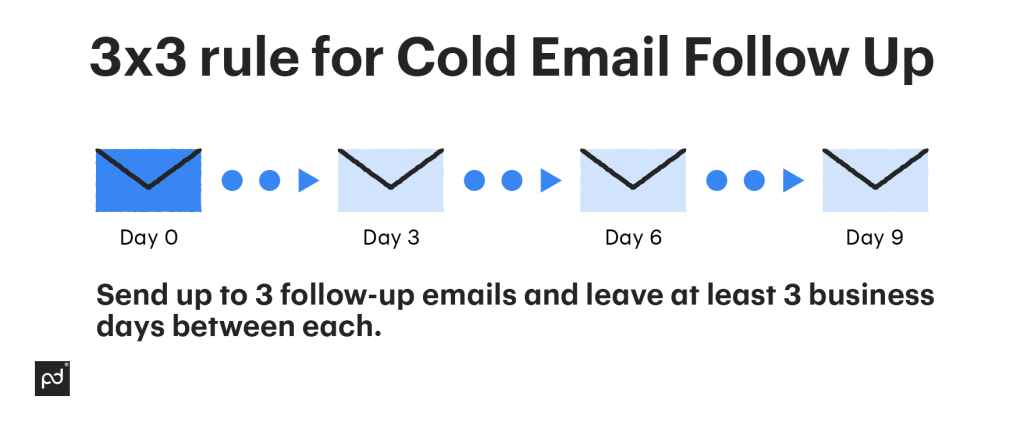
10. Test different approaches and measure outcomes
The only way to know how successful your strategy is is to measure outcomes. Did you achieve the goal you set out in the beginning? If not, by how much? What do you think are the reasons?
The only way to see what works best is to test a few different approaches, either in the same email campaign or in the future.
You can test different versions of:
- Subject lines: Short and vague or long and detailed? Include the first name or not? Experiment to find out.
- Intros: Present yourself and the company or say what’s in it for them. Or speak about their pain point?
- Templates: Testing a few different templates that you write will enable you to make sure you have the right approach for each segment.
- CTAs: There are many different ways to ask for the same thing, so test a few different approaches.
- Personalization tactics: Should you talk about the person’s or the company’s recent achievements? Should you mention that paper they wrote? Again, experiment to find out.
There’s one important consideration to make, though: Whenever you test something, you need to make sure that you’re doing it in a way that you can actually compare results.
For A/B testing for email marketing (cold emailing included), this means:
- Change one thing at a time
- Test each strategy with a sufficient number of recipients
- Test in parallel to avoid time-based factors influencing your results
11. Deliver what you promised
So, a prospect said yes and signed up for your webinar, or requested a cost estimate or a quote — what’s next?
Well, now you need to deliver what they asked for and do it fast.
After all, it was you who contacted them, so you need to be certain you have the capacity to move quickly and provide what you promised.
As we mentioned up top, at PandaDoc, we’re invested in making sure you have that capacity to deliver.
Our platform has all the tools you need to manage your docs and sales collateral, all in one place, and all free to try out for 14 days — the perfect companion to all the knowledge you just acquired!
Cold emails can be a successful marketing strategy if executed correctly
Cold emails have a bad rap but that’s not really related to whether they’re a good marketing strategy — it’s because they’re (1) difficult to get right and (2) very often poorly executed.
But if you spend the time and resources to build a cold email strategy from the ground up, by using the best practices and tools we’ve discussed here, and actually craft personalized messages each time you send an email, you’ll have another high-performing sales tool in your toolbox.
Go get ‘em!


